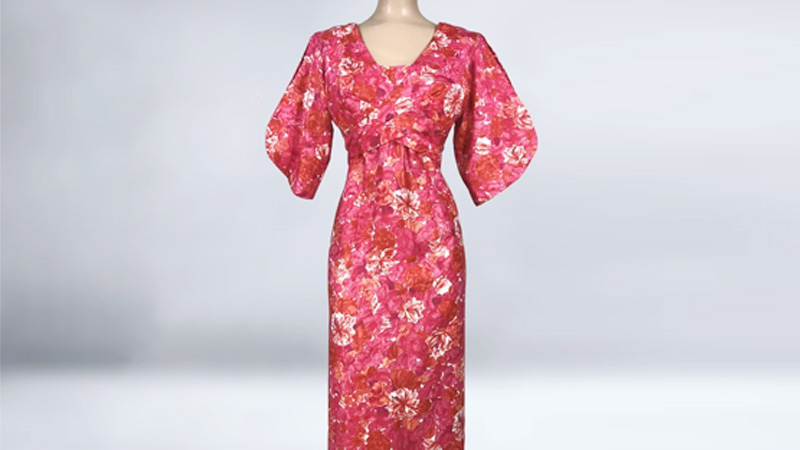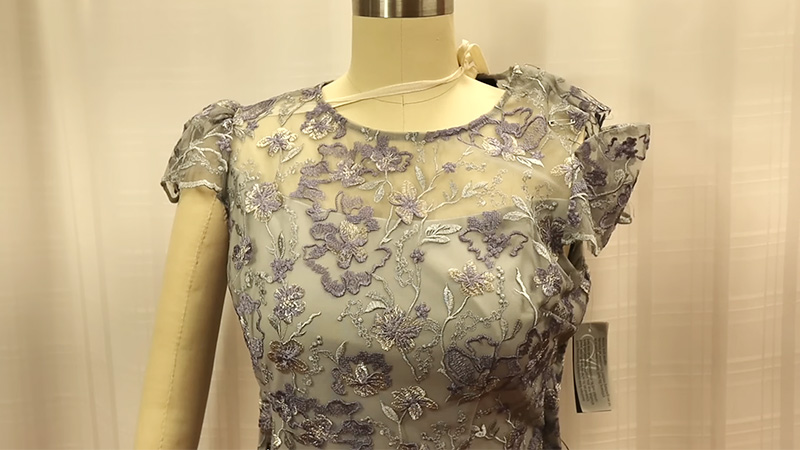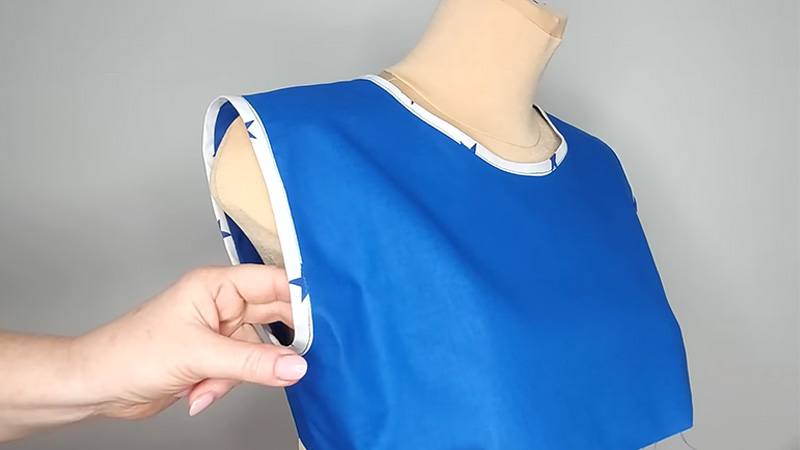Altering a dress bust is a transformative skill for anyone who enjoys sewing or wishes to achieve a perfect fit in their clothing.
Whether you’re working with a store-bought garment or crafting a custom-made dress from a pattern, mastering this technique can enhance comfort and confidence.
This process involves adjusting the bust area’s dimensions to align with your unique body shape, ensuring that your dress drapes beautifully and feels tailored to you.
From taking precise measurements to making careful fabric adjustments and considering the dress’s style, this guide will walk you through the essential steps, empowering you to create or modify dresses that flatter and fit flawlessly.

How to Alter a Dress Bust?
Altering the bust of a dress can be a bit tricky, especially if it involves major adjustments. It’s often best to have a professional seamstress or tailor perform this alteration.
However, if you have some sewing skills and feel confident in making minor adjustments, here are steps to help you alter the bust of a dress:
Tools and Materials
- Dress in need of alteration
- Sewing machine (or needle and thread if hand-sewing)
- Pins
- Measuring tape
- Chalk or fabric marker
- Scissors
- Seam ripper (for undoing seams, if necessary)
- Iron and ironing board
Steps:
Measurements
Put on the dress and carefully assess how much adjustment is needed in the bust area.
Take precise measurements, including the distance between your bust points and compare these measurements to the current dimensions of the dress.
Pin the Dress
With the dress still on, begin pinning it to create the desired fit around the bust. Start at the center and work your way outward, ensuring the pins are evenly spaced and securely hold the fabric.
These pins should form a new seam line that matches the shape you want the bust to have.
Mark with Chalk
While wearing the dress, use chalk or a fabric marker to mark the new seam lines you’ve created with the pins.
Ensure that these marks are symmetrical on both sides of the dress and accurately represent the desired alterations. Double-check the fit by looking in the mirror and making any necessary adjustments.
Take Off the Dress
Carefully remove the dress while keeping the pins in place. This will allow you to work on the dress more comfortably.
Seam Rip (if necessary)
If the dress already has seams in the bust area that need to be adjusted, use a seam ripper to carefully undo these seams.
This step may be necessary to allow you to make precise alterations to the fabric.
Sew the New Seam
Using either a sewing machine or hand-sewing, follow the chalk or fabric marker lines to sew the new seams you marked during the fitting. Be sure to maintain a consistent seam allowance and start from the top of the bust, sewing down to the desired point. Create a curved seam that matches your measurements.
Try It On
Put the dress back on to ensure the fit is as desired. Check for any tight or loose spots and make any necessary adjustments, such as taking in or letting out the seams further.
Trim and Finish Seams
Trim any excess fabric from the newly sewn seams, and finish the raw edges. You can use a zigzag stitch or a serger to prevent fraying.
Afterward, press the seams with an iron to set them in place and make them look neat.
Final Fitting and Hemming (if necessary)
Try on the dress once more to confirm that it fits properly. Pay attention to any areas that may require further adjustments.
If the dress has a hem, check if it needs to be shortened or lengthened due to the bust alteration.
Press the Dress
Give the entire dress one final press with an iron to ensure all seams and alterations look crisp and tidy.
Optional: Add Bust Darts (if necessary)
Depending on the dress’s style and your body shape, you may need to add bust darts for a more accurate fit, especially on fitted bodices.
Adjust these darts as needed during the fitting process.
Optional: Lining Adjustments (if necessary)
If the dress includes a lining, make corresponding adjustments to the lining as well to maintain a consistent fit.
Ensure that the lining matches the alterations made to the outer fabric.
How Do you Make the Bust of your Dress Smaller?

To make the bust of your dress smaller, you will need to take in the fabric in the bust area. Here’s a step-by-step guide on how to do it:
Tools and Materials
- Dress in need of alteration
- Sewing machine (or needle and thread if hand-sewing)
- Pins
- Measuring tape
- Chalk or fabric marker
- Scissors
- Seam ripper (for undoing seams, if necessary)
- Iron and ironing board
Here Are Some Steps:
Measurements
Put on the dress and assess how much you need to reduce the bust area. Take precise measurements to determine the exact amount of alteration needed.
Measure the distance between your bust points and compare it to the current measurement of the dress.
Pin the Dress
Start by pinning the dress to create the desired fit around the bust.
Begin at the center and work your way outwards, ensuring the pins are evenly spaced and securely hold the fabric.
The pins should follow the shape you want the smaller bust to have.
Mark with Chalk
While wearing the dress, use chalk or a fabric marker to mark the new seam lines created by the pins.
Ensure that the marks are symmetrical on both sides of the dress and accurately represent the reduced bust size.
Take Off the Dress
Carefully remove the dress while keeping the pins and chalk marks in place. This will allow you to work on the dress more comfortably.
Seam Rip (if necessary)
If the dress already has seams in the bust area that need to be adjusted, use a seam ripper to carefully undo these seams.
This step may be necessary to allow you to make precise alterations to the fabric.
Sew the New Seams
Using your sewing machine or hand-sewing, follow the chalk or fabric marker lines to sew the new seams you marked during the fitting. Be sure to maintain a consistent seam allowance.
Start from the top of the bust, sewing down to the desired point, creating a curved seam that matches your reduced measurements.
Try It On
Put the dress back on to ensure the fit is as desired with the smaller bust. Check for any tight or loose spots and make any necessary adjustments, such as taking in or letting out the seams further.
Trim and Finish Seams
Trim any excess fabric from the newly sewn seams and finish the raw edges by using a zigzag stitch or a serger to prevent fraying.
Press the seams with an iron to set them in place and make them look neat.
Final Fitting and Hemming (if necessary)
Try on the dress once more to confirm that it fits properly with the smaller bust. Pay attention to any areas that may require further adjustments.
If the dress has a hem, check if it needs to be shortened or lengthened due to the bust alteration.
How Do You Do a Bust Adjustment on a Pattern Before Sewing a Dress?

A bust adjustment, often called a Full Bust Adjustment (FBA) or Small Bust Adjustment (SBA), is a common alteration made to a sewing pattern to ensure a better fit around the bust area.
Here’s how you can perform a bust adjustment on a pattern before sewing a dress:
Materials:
- Sewing pattern
- Pattern paper or tracing paper
- Ruler
- Pencil
- Tape
- Scissors
- Measuring tape
Steps:
Select the Correct Pattern Size
Start by selecting the sewing pattern size that matches your body measurements at the high bust or upper chest area. This ensures that the dress will fit well on the shoulders and neck.
Measure Your Bust
Measure your full bust at the fullest point while wearing the type of undergarments you plan to wear with the dress. Write down this measurement.
Calculate the Adjustment Amount
Find the difference between your full bust measurement and the bust measurement indicated on the pattern for your selected size.
This difference is the amount you need to adjust the pattern by.
Determine Adjustment Style (FBA or SBA)
Decide whether you need to make a Full Bust Adjustment (FBA) or a Small Bust Adjustment (SBA) based on your body shape and the pattern’s fit.
FBA (Full Bust Adjustment)
If your full bust measurement is larger than the pattern’s bust measurement, you’ll need an FBA. This adjustment adds width to the bust area while maintaining the pattern’s proportions.
SBA (Small Bust Adjustment)
If your full bust measurement is smaller than the pattern’s bust measurement, you’ll need an SBA. This adjustment reduces the width in the bust area while maintaining the pattern’s proportions.
Mark the Pattern
Start with a copy of your pattern on pattern paper or tracing paper.
FBA (Full Bust Adjustment):
Draw horizontal lines on the pattern: One line at the bust level (usually across the bust apex).
A second line above the bust, parallel to the first line, approximately 1-2 inches (2.5-5 cm) above the bust apex.
Make vertical slashes from the bust level line up to but not through the upper line, spaced evenly around the bust area (typically 2-3 slashes).
Cut along these slashes, leaving a small hinge at the upper line.
Spread the pattern pieces to add the required width. Tape additional paper underneath to fill the gaps created by the spread.
SBA (Small Bust Adjustment)
Draw horizontal lines on the pattern: One line at the bust level (usually across the bust apex).
A second line below the bust, parallel to the first line, approximately 1-2 inches (2.5-5 cm) below the bust apex.
Make vertical slashes from the bust level line down to but not through the lower line, spaced evenly around the bust area (typically 2-3 slashes).
Cut along these slashes, leaving a small hinge at the lower line. Overlap the pattern pieces to reduce the width.
Use the calculated adjustment amount from Step 3. Tape the overlapped sections together.
Adjust the Dart
If the pattern has a bust dart, you may need to adjust its size and placement to accommodate the adjustment.
Make sure the dart apex remains the same distance from the bust level line as before the adjustment.
Finalize and Cut Fabric
Once you are satisfied with the fit of the toile, you can confidently use the adjusted pattern to cut your dress fabric and proceed with sewing.
FAQs
You’ll need pins, a measuring tape, chalk or fabric markers, scissors, a sewing machine or needle and thread, an iron, and a seam ripper if existing seams need adjustment.
While some alterations are more complex, basic adjustments like taking in or letting out seams can be manageable for beginners.
If your dress feels tight, loose, or gaps at the bust, or if there are wrinkles and folds in the fabric in that area, it may need a bust adjustment.
Yes, it’s possible to adjust the lining to match the changes made to the outer fabric, ensuring a consistent fit.
It depends on your sewing skills and the level of adjustment needed. Pattern adjustments can provide a more customized fit from the start, while altering a ready-made dress can revitalize existing garments.
To Recap
The art of altering a dress bust is a valuable skill that opens the door to personalized and well-fitting attire.
By understanding the intricacies of measurement, pinning, and sewing, you gain the ability to adapt dresses to your unique body shape and style preferences.
Whether you seek to enhance comfort, revitalize an old garment, or create a tailored masterpiece, this process empowers you to take control of your wardrobe.
With careful attention to detail, precision, and the guidance of professional seamstresses or your own expertise, you can ensure that your dresses drape elegantly and make you feel confident and beautiful every time you wear them.
Leave a Reply